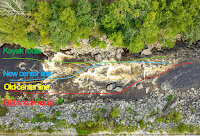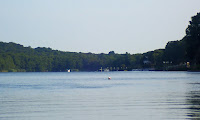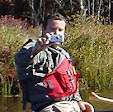 |
| Hangover Helper |
It was a typical release for this time of year – 800 cfs from 12:00 to 4:00. The Charlemont gage hit around 850 cfs with water flowing in from the small creeks. We had a group of 6 - 2 canoes, 2 kayaks and 2 paddle boards. We met at 11:30 to run the shuttle. We started downstream a little after 12:00. With a small group things go fast, but we still spent a lot of time playing.
 |
| Freight Train |
This was my second trip in my Millbrook Outrage, and I am really liking it. It surfs great and I bail it out with a sponge. The only problem is dumping the boat is no longer an excuse to get out and stretch.
Links:
My Pictures
Fife Brook release Schedule
Charlemont Gage



















































